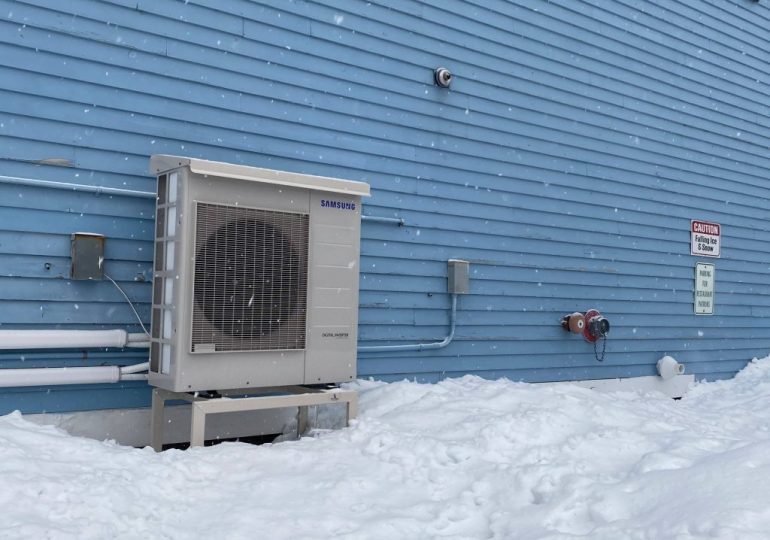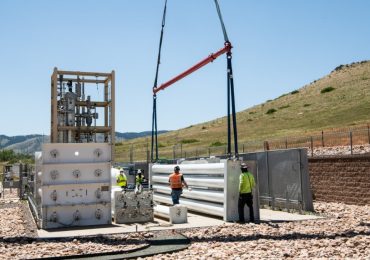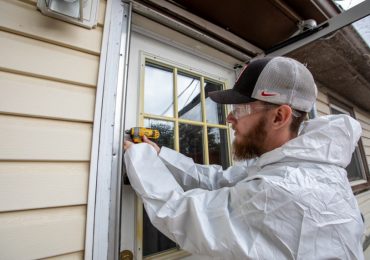New state incentives are pushing Mainers to adopt “whole-house” heat pump systems, making efficient electricity the primary home heat source and discouraging the secondary use of oil or gas.
Federal tax credits are still available for a wider range of heat pump installations, and the state offers rebates for low-income households to install a heat pump as a supplemental heat source.
But the latest big rebate for families of any income in Maine, which has become a national leader in heat pump adoption, focuses on using this technology to heat and cool the user’s entire house — or close to it.
“Customers are then able to turn off their old central furnace or boiler, relegating it to an emergency backup system,” said Michael Stoddard, the executive director of the state’s energy incentives agency, Efficiency Maine, in an email. “When that happens, (heat pumps) are able to meet their full potential.”
The agency’s new whole-house rebate program aims to help meet Maine’s climate goals. First rolled out this fall, the rebate was revised in recent weeks in response to criticism and confusion from contractors over its compliance rules.
What are whole-house heat pump systems?
A whole-house heat pump system — also called whole-home, or whole-facility in a space like a school or business — means that heat pumps are the go-to source of heating in the winter, with any supplemental sources used infrequently or as emergency backups.
To receive Efficiency Maine’s new rebate, which covers 40% of project costs up to a $4,000 cap for people of any income or more for those of lower incomes, a heat pump system must be sized to serve at least 80% of the home’s potential heating load, from shoulder seasons to the coldest day of winter.
Eben Perkins, the chief strategy officer with the Maine-based energy consulting firm Competitive Energy Services, said this is just one way of defining a whole-house heat pump in the grand scheme: For example, his company tends to look at how much heat pumps are serving a client out of the whole year, rather than on a day-to-day basis.
What role do whole-house systems play in Maine’s climate goals?
Maine home heat targets are based on modeling of how many heat pumps and weatherization jobs it would take to offset the state’s top-in-the-nation reliance on heating oil and other use of fossil fuels in buildings, with statutory targets of cutting emissions 45% over 1990 levels by 2030 and 80% by 2050.
This sector, which includes schools, businesses and more along with homes and apartments, is second only to transportation in contributing to Maine’s emissions.
This past summer, the state hit an initial target of installing 100,000 heat pumps relative to 2019. Now, it’s working toward another 175,000 more units by 2027. Stoddard said the goal is to see 130,000 homes with one or two heat pump units by 2030, and 115,000 more with whole-house systems.
“The efficiency levels of heat pumps can be two-X, three-X, four-X technology compared to a combustion system. So one, it’s just a good technology that keeps on getting better,” said Perkins. “Second, it gives you a pathway to actually fully decarbonize the upstream fuel source… That’s the pathway we need to really deeply cut emissions at the state (level).”
Maine had about 580,000 households in 2022, per the U.S. Census, and about 56% of them use heating oil, according to federal data — slightly lower than in recent years, but still the highest rate in the country.
The state aims to make its energy usage 100% renewable by 2040.
Can you use fossil fuels alongside whole-house heat pumps?
The answer is technically yes, but ideally no, at least under Maine’s new rebate.
As they switch to whole-house heat pumps, eligible customers are asked to turn their oil- or gas-powered furnaces or boilers and connected thermostats off or all the way down, and to cover the systems’ switches. They can still use these systems for hot water heating or in connection with an emergency generator.
This fall, Maine walked back an earlier requirement that old fossil-fired systems be disabled or disconnected from electrical service entirely, with locks on their switches, amid pushback from heat pump installers and fuel oil vendors about reliability and other concerns.
Despite reverting the rebate to more of an honor system, Stoddard said avoiding supplemental fossil fuel use as completely as possible is key to maximizing heat pump benefits.
“Our research shows that the majority of heat pumps installed in Maine will save significantly less money and emissions when they are operated concurrently with a central furnace or boiler than when they operate alone,” he said.
The rebate rules suggest “room heaters, a wood stove, or small space heaters,” Stoddard said, to cover up to 20% of the home’s heating load alongside the whole-house heat pump system.
Why does Maine focus on a certain approach to whole-house heat pumps?
In theory, a whole-home heat pump system could have a range of configurations. But Efficiency Maine focuses its new rebates on heat pumps with one indoor unit per outdoor unit (which they call “single zone,” though contractors say this can have different meanings). These might be the customer’s first heat pumps, or they might add on to older units to make up that 80% heating overall capacity required by the state.
Dave Ragsdale, the HVAC division manager at Maine-based ReVision Energy, said heat pumps need to be carefully tailored to a home’s needs to maximize their efficiency.
“You really need to have the… capacity of your heat pump system match the heat load of the house as closely as possible,” he said. “To the extent you oversize a heat pump system, you’re creating a situation where it’s beginning to resemble, more and more, an old-fashioned heating system.”
Traditional boilers and furnaces, he said, are almost always far oversized to the house’s heating needs — because they can be. “When you have a call for heat in a room, the thermostat tells the boiler, ‘we need heat,’ (and) turns the boiler on. It doesn’t matter how many (units of heat) that boiler is rated for — it’s only going to run for as long as it needs to to get heat to that room to satisfy that thermostat,” Ragsdale said.
Heat pumps are different, he said: They perform best when they can run pretty much constantly and modulate their output in response to temperature needs. If a heat pump is sized to provide more heat than the house could ever need — or, say, if one outdoor compressor is sized to run heat pump heads in four rooms, though only one or two may be used at a time — it can lead to costly, inefficient “short-cycling.”
“As soon as (the oversized heat pump) turns on, its capacity is way in excess of the load,” Ragsdale said. “So almost immediately, it floods the room with heat and then turns off, and then the room loses heat, and then it turns on again,” much like a traditional fossil fuel-fired system.
Ragsdale said this need for fine-tuning is why Maine’s rebate focuses on those one-indoor, one-outdoor, “single-zone” units — and why he suggests customers choose whole-house systems that meet just a tiny bit less than their home’s peak hypothetical heating load, ideally 99% or 99.6% of it.
“That little adjustment is enough to bring the capacity of your system more in line with what you’re actually going to see throughout the course of the heating season,” Ragsdale said.
If pushed to 100%, the system would be overpowered almost every day of the year, reducing efficiency and driving up costs. In the 99% design, the whole-house system is more efficient year-round and can use its supplemental sources to take the edge off and improve performance in the coldest weather conditions.
Are whole-house heat pump systems right for every house?
Getting the most out of a whole-house system requires careful customer education and for contractors to assess a home’s energy needs in great detail, Ragsdale said. Assessing air leaks and insulation needs with an energy audit can be a key part of this process. Ultimately, he sees houses with a more open floor plan and excellent weatherization as the best candidates for a cost-effective whole-house system.
“One thing is crystal clear… this whole-house model is not going to be applicable to every house you come across,” he said. “If there’s a house that’s broken up into a lot of small rooms, it’s probably going to be difficult to make a (whole-house) heat pump system work really well there.”
The same goes for using existing ducts from a forced hot-air system to run heat pumps, accompanied by an air handler. Those ducts will need new insulation to safely carry cold air in the summer, which is a complex retrofit for an existing house. Even at best, Ragsdale said, “you’re losing a fair amount of (heat) in the distribution” relative to a ductless heat pump delivering its hot air more directly.
But for people who may be unsure or ill-suited for the whole-house switch, Ragsdale emphasized that other heat pump configurations can still help vastly reduce fossil fuel use and costs, especially with state and federal incentives.
“Heat pumps still make sense, even a house that doesn’t have the perfect layout,” he said.
He gave his own home as an example. It was built in the 1940s, with lots of small rooms.
“I put one (heat pump unit) in my living room, which is the single biggest room, so I’m taking a big chunk out of my heat load even before I stop using my boiler altogether,” he said. “Most of that heat, frankly, in the shoulder seasons, managed to get its way around the house enough so that I was perfectly comfortable.
“Only in a couple weeks out of the winter,” he said, “did I have to turn that boiler on to … take the chill off.”
Maine turns its heat pump focus to ‘whole-house’ systems that can all but eliminate fossil fuel use is an article from Energy News Network, a nonprofit news service covering the clean energy transition. If you would like to support us please make a donation.
Leave a comment









